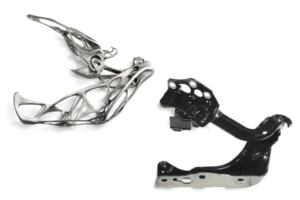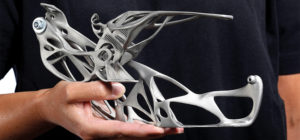Simufact Additive Simulation Software Leads to Real Advances for toolcraft and Collaborative LightHinge+ 3D Printing Project
 Last fall, simulation software company Simufact introduced its Simufact Additive solution for metal 3D printing users, to help eliminate wasted time and money by getting rid of failed prints. The software, which covers the whole manufacturing process chain for powder bed fusion 3D printing processes, is meant to optimize metal 3D printing as a scalable process simulation environment, and allows users to simulate all aspects of the process, from printing and heat treatment to support structure removal.
Last fall, simulation software company Simufact introduced its Simufact Additive solution for metal 3D printing users, to help eliminate wasted time and money by getting rid of failed prints. The software, which covers the whole manufacturing process chain for powder bed fusion 3D printing processes, is meant to optimize metal 3D printing as a scalable process simulation environment, and allows users to simulate all aspects of the process, from printing and heat treatment to support structure removal.
 Recently, Germany-based full service 3D metal printing provider and high-end precision part manufacturer toolcraft chose Simufact Additive to drastically improve service for its customers by moving up from trial and error to a more predictive process, simulating the 3D printing processes ahead of the physical build to make it more efficient and cost-effective.
Recently, Germany-based full service 3D metal printing provider and high-end precision part manufacturer toolcraft chose Simufact Additive to drastically improve service for its customers by moving up from trial and error to a more predictive process, simulating the 3D printing processes ahead of the physical build to make it more efficient and cost-effective.
“We have tested Simufact Additive extensively and saw that the solution is going to help us in our daily practice. Our clients expect us to examine the feasibility of 3D printing orders in the early project phase – the simulation of the manufacturing process is the key to this,” said Christoph Hauck, Managing Director of toolcraft. “In the course of further optimization of additively manufactured parts, simulation supplies us with fast and economical indications on how the printing process with different support structures, different orientations within the build space as well as changed machine parameters behave.”
 The software simulates the initial build job and post-processing, and is able to calculate residual stresses and distortions in the component, offering the user a look at the risk of build job abortions. By simulating 3D printing processes using Simufact Additive, toolcraft can predict these issues to offer users a way to develop good countermeasures ahead of printing, which reduces the number of attempted print jobs that are needed in the process of creating a successful build.
The software simulates the initial build job and post-processing, and is able to calculate residual stresses and distortions in the component, offering the user a look at the risk of build job abortions. By simulating 3D printing processes using Simufact Additive, toolcraft can predict these issues to offer users a way to develop good countermeasures ahead of printing, which reduces the number of attempted print jobs that are needed in the process of creating a successful build.
Michael Wohlmuth, Managing Director and CEO at Simufact, said, “Simufact and Toolcraft will continue to collaborate very closely on best practices to optimize the metal additive manufacturing processes. With Toolcraft we found a partner who is an expert at the additive manufacturing process and shares our goal to dramatically improve the process.”
Simufact Additive is used mostly by suppliers, service providers, and companies in the aerospace and automotive sectors; Simufact Engineering GmbH just announced that it has partnered up with voestalpine Additive Manufacturing Center and EDAG Engineering GmbH, under the umbrella of joint project LightHinge+, to demonstrate the potential, and practical use, of additive manufacturing in automotive production. The project itself combines increased safety and lightweight construction in one build – a 3D printed hood hinge.
“Engine hood hinge systems are very complex because of the high demands on safety and functionality. This means that lightweight construction is still on the line,” explained Dr. Martin Hillebrecht, Head of Competence Center Lightweight Construction, Materials and Technologies at EDAG Engineering. “That is why, together with voestalpine and Simufact, we have set ourselves the goal of rethinking the hinge by means of generative production.”
EDAG engineers have already redesigned the hinge system, and then partners had to get to their desired weight advantage for the component structure by using topology optimization and 3D printing. EDAG used bionic principles to find the minimum material requirements, while voestalpine worked with the company to optimize the support structures to ultimately, Simufact explained, “achieve a 50% weight advantage over the reference.”
- Comparison hood hinge: Additive and traditional construction
Dr. Eric Klemp, Managing Director of the voestalpine Additive Manufacturing Center in Düsseldorf, Germany, said, “The topology optimization calculates the minimal material requirements of the hinge. The resulting components geometries require a high proportion of support structures, which we could then minimize to a minimum in the project.”
 Simufact Additive was used to simulate the 3D printing build process, and subsequent process steps, for the component, in order to predict residual stresses and distortions ahead of time.
Simufact Additive was used to simulate the 3D printing build process, and subsequent process steps, for the component, in order to predict residual stresses and distortions ahead of time.
“In the additive manufacturing process, the concentrated heat input with high heating and cooling rates causes distortion and residual stresses in the component. A non-distortion-compensated hinge can thus deviate from one to two millimeters to the reference geometry respectively,” explained Simufact Product Manager Additive Manufacturing Dr. Patrick Mehmert.
“On the basis of simulated distortion, we have negatively deformed the component geometry so as to minimize the shape deviations of the printed hinges to the target geometry.”
 The build process simulation played a major role in improving the design, protection, and distortion optimization of the 3D printed hinge, and helped prevent costly, time-intensive production tests. After the parts were printed, AICON 3D Systems performed a 3D optical measurement to prove that the components had accurate dimensions, and the voestalpine Additive Manufacturing Center had a successful 3D printed hinge on its hands, which saved money, resources, time, and will be ready for use as soon as the laser melting process is complete.
The build process simulation played a major role in improving the design, protection, and distortion optimization of the 3D printed hinge, and helped prevent costly, time-intensive production tests. After the parts were printed, AICON 3D Systems performed a 3D optical measurement to prove that the components had accurate dimensions, and the voestalpine Additive Manufacturing Center had a successful 3D printed hinge on its hands, which saved money, resources, time, and will be ready for use as soon as the laser melting process is complete.
“The LightHinge+ hood hinge fully exploits the potential of additive manufacturing by means of efficient software-assisted engineering. An ultimate weight reduction and integration of a pedestrian protection function, in distortion and self-tension optimized tool-less production with little rework for small series is achieved,” said Dr. Hillebrecht.
If you’re interested in more information on the collaborative LightHinge+ project, the three partners will presenting the results of the project at EDAG’s stand in Hall 5.1, Booth B04 at the IAA exhibition in Germany, which starts tomorrow.
[All Images: Simufact]Discuss this story, and other 3D printing topics, at 3DPrintBoard.com, or share your thoughts in the Facebook comments below.
Subscribe to Our Email Newsletter
Stay up-to-date on all the latest news from the 3D printing industry and receive information and offers from third party vendors.
Print Services
Upload your 3D Models and get them printed quickly and efficiently.
You May Also Like
3D Printing News Briefs, July 2, 2025: Copper Alloys, Defense Manufacturing, & More
We’re starting off with metals in today’s 3D Printing News Briefs, as Farsoon has unveiled a large-scale AM solution for copper alloys, and Meltio used its wire-laser metal solution to...
3DPOD 260: John Hart on VulcanForms, MIT, Desktop Metal and More
John Hart is a Professor at MIT; he´s also the director of the Laboratory for Manufacturing and Productivity as well as the director of the Center for Advanced Production Technologies....
3D Printing News Briefs, June 28, 2025: Defense Accelerator, Surgical Models, & More
In this weekend’s 3D Printing News Briefs, 3YOURMIND was selected to join an EU Defense Accelerator, and PTC has announced model-based definition (MBD) capabilities within Onshape. Finally, a study out...
EOS in India: AM’s Rising Star
EOS is doubling down on India. With a growing base of aerospace startups, new government policies, and a massive engineering workforce, India is quickly becoming one of the most important...




































